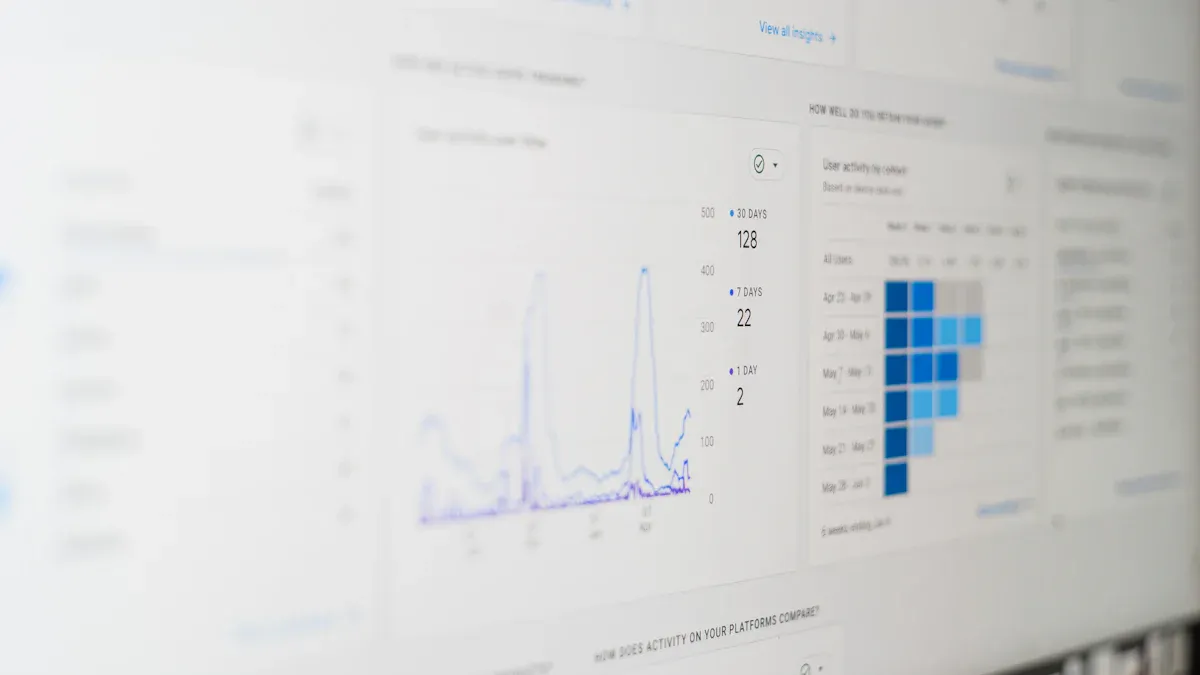
Knowing what customers think is more important than ever. Sentiment analysis helps you understand feelings in text for better choices. Companies using sentiment analysis see amazing benefits:
-
83% make customers happier in just one year.
-
Predicting new software use becomes 74% correct, lowering risks.
-
Launching products gets 37% faster, and more people use them, up by 28%.
-
Businesses gain a 287% return by keeping customers and wasting less.
As the sentiment analysis market grows to $11.4 billion by 2030, using the right tools helps you improve plans, services, and stay ahead.
Key Takeaways
-
Sentiment analysis helps businesses know how customers feel. This improves products and services.
-
Using sentiment analysis can make customers 83% happier in a year. It also builds loyalty.
-
Picking the right tool is important. Look at cost, features, and how easy it is to use.
-
Advanced tools find emotions in text. They help businesses act fast on feedback and trends.
-
Clean and prepare data often for better results. This is very important for social media.
What Is Sentiment Analysis and Why Does It Matter?
Definition of Sentiment Analysis
Sentiment analysis helps understand feelings and opinions in written text. It uses tools to find out if a message feels positive, negative, or neutral. For example, analyzing a product review shows if someone liked it or not. This method is also called text analysis because it studies text to uncover emotions.
You can use sentiment analysis to check customer feedback, social media posts, or surveys. It shows how people feel about your brand, products, or services. This helps you make better choices to keep customers happy.
Key Applications Across Industries
Sentiment analysis solves problems in many industries. Here are some examples:
-
Social media sentiment analysis: Companies track platforms like Twitter to see opinions about their brand. They respond quickly to bad comments to protect their image.
-
Customer service: Businesses study customer chats to fix problems faster and improve replies.
-
Market research: By reading reviews, companies spot trends and design better products.
-
Healthcare: Hospitals use feedback to learn what patients need and improve care.
-
Finance: Investors use news data to make smarter money decisions.
These examples show how sentiment analysis helps businesses stay ahead and meet customer needs.
Benefits of Sentiment Analysis in 2025
In 2025, sentiment analysis will be even more useful. The market for this software will grow to $2163.3 million, increasing by 13.6% yearly. This growth comes from more text data like social media posts and online reviews.
Here’s how sentiment analysis helps businesses:
-
It shows customer feelings, so you can improve products and services.
-
It finds negative feedback fast, helping you fix issues quickly.
-
It builds loyalty by showing customers their opinions matter.
-
It keeps you ahead by spotting market trends in real time.
-
It improves your brand by tracking public views and making changes.
Using sentiment analysis helps you make smarter choices and connect better with customers.
Top 10 Sentiment Analysis Tools for 2025
Tool 1: IBM Watson Natural Language Understanding – Features and Use Cases
IBM Watson Natural Language Understanding is a smart tool for sentiment analysis. It uses AI to study text and find emotions, opinions, and intent. This tool works well with big data from social media, reviews, and surveys.
Features:
-
Emotion Analysis: Finds feelings like happiness, sadness, anger, and fear in text.
-
Entity Recognition: Spots important names like people, places, and companies.
-
Customizable Models: Lets you create models for your specific needs.
-
Scalability: Works smoothly with both small and large data sizes.
Use Cases:
-
Customer Feedback Analysis: Learn what customers think about your products or services.
-
Social Media Monitoring: Check how people feel about your brand online.
-
Market Research: Discover trends to help design better products.
IBM Watson is great for businesses needing a strong tool that works with other IBM systems.
Tool 2: Brandwatch – Features and Use Cases
Brandwatch is a top tool for tracking online opinions about your brand. It helps you see what people say and respond quickly to feedback.
Features:
-
Social Listening: Finds mentions of your brand on many websites.
-
Sentiment Scoring: Gives each mention a score to show public feelings.
-
Data Visualization: Makes charts and graphs for easy understanding.
-
AI-Powered Insights: Uses AI to find hidden trends in the data.
Use Cases:
-
Crisis Management: Spot and fix bad opinions fast to protect your brand.
-
Campaign Performance: See how your ads affect audience feelings.
-
Competitor Analysis: Compare your brand’s image with others to improve.
Brandwatch is perfect for marketers who want to stay ahead in their field.
Tool 3: Talkwalker – Features and Use Cases
Talkwalker is a flexible tool for sentiment analysis. It can study text, pictures, and videos, making it a complete solution for businesses.
Features:
-
Multimedia Analysis: Checks text, images, and videos for emotions and meaning.
-
Real-Time Alerts: Warns you about big changes in opinions right away.
-
Hashtag Tracking: Tracks hashtags and their related feelings.
-
Global Coverage: Works in many languages, great for worldwide brands.
Use Cases:
-
Brand Monitoring: See how people feel about your brand across media types.
-
Event Analysis: Track audience feelings during events or launches.
-
Customer Experience: Understand customer opinions to make them happier.
Talkwalker is ideal for businesses wanting to analyze more than just text.
Tool 4: Awario – Features and Use Cases
Awario is a tool that helps track online talks about your brand. It gives quick updates on customer opinions, so you can act fast.
Features:
-
Real-Time Monitoring: Awario checks social media, blogs, forums, and news for mentions of your brand.
-
Sentiment Analysis: It shows if mentions are positive, negative, or neutral to understand public feelings.
-
Boolean Search: This lets you create specific searches to find the best mentions.
-
Competitor Analysis: Awario compares your brand's reputation with competitors to help you improve.
-
White-Label Reports: Make custom reports to share insights with your team or clients.
Use Cases:
-
Brand Reputation Management: Awario helps you find and fix bad feedback about your brand.
-
Customer Engagement: Use Awario to reply to customer questions or complaints quickly.
-
Market Research: Study trends and opinions to make better marketing plans.
Awario is a smart choice for businesses wanting a budget-friendly tool with many features.
Tool 5: Lexalytics – Features and Use Cases
Lexalytics is a software that handles large amounts of text data. It uses smart language tools to give clear and accurate results.
Features:
-
Text Mining: Lexalytics finds useful details in reviews, surveys, and social media posts.
-
Sentiment Scoring: It gives each text a score to show customer feelings.
-
Multilingual Support: The tool works in many languages, great for global companies.
-
Customizable Models: Change the tool to match your business needs.
-
API Integration: Connect Lexalytics easily to your current systems.
Use Cases:
-
Customer Feedback Analysis: Study reviews and surveys to make your products or services better.
-
Social Media Monitoring: Learn what people think about your brand on platforms like Twitter.
-
Healthcare Insights: Hospitals can use it to understand patient feedback and improve care.
Lexalytics is perfect for big companies needing flexible and scalable tools.
Tool 6: Clarabridge – Features and Use Cases
Clarabridge is a top tool for studying customer feedback. It’s popular with big companies because it handles complex data well.
Features:
-
Omnichannel Analysis: Clarabridge looks at data from social media, emails, and call centers.
-
Emotion Detection: It finds feelings like frustration or happiness in customer feedback.
-
Root Cause Analysis: The tool shows why customers feel a certain way, helping fix problems.
-
Voice of the Customer (VoC) Insights: It gives a full view of customer opinions for smarter decisions.
-
AI-Powered Analytics: Its AI makes analyzing big data fast and accurate.
Use Cases:
-
Customer Experience Management: Clarabridge helps improve how customers interact with your brand.
-
Product Development: Use feedback to make better products or services.
-
Employee Feedback Analysis: Companies can study staff opinions to improve workplace happiness.
Clarabridge is great for large businesses needing detailed feedback from many sources.
Tool 7: MonkeyLearn – Features and Use Cases
MonkeyLearn is a simple tool for sentiment analysis. It works for businesses of all sizes. You don’t need coding skills to use it. MonkeyLearn helps you study customer feedback, social media posts, and surveys.
Features:
-
No-Code Interface: Build models easily with drag-and-drop tools.
-
Pre-Trained Models: Use ready-made models for tasks like finding keywords.
-
API Integration: Connect MonkeyLearn to tools like Google Sheets or Zendesk.
-
Real-Time Analysis: Get quick results to understand customer opinions fast.
-
Customizable Dashboards: Make visual reports to share trends with your team.
Use Cases:
-
Customer Feedback Analysis: Study reviews to find ways to improve products.
-
Social Media Monitoring: Check how people feel about your brand online.
-
Employee Feedback: Learn what workers think about workplace changes.
-
Market Research: Spot new trends by studying surveys and online talks.
MonkeyLearn is great for businesses needing a fast, no-code solution.
Tool 8: RapidMiner – Features and Use Cases
RapidMiner is a strong platform for sentiment analysis and data science. It helps users explore data deeply and find useful insights.
Features:
-
End-to-End Workflow: Handle everything from preparing data to using models.
-
Machine Learning Algorithms: Build accurate models with many algorithm choices.
-
Visual Workflow Designer: Drag-and-drop tools make complex tasks simple.
-
Integration Capabilities: Connect RapidMiner to databases and cloud services.
-
Scalability: Works well for small tasks or big company projects.
Use Cases:
-
Product Development: Study reviews to improve product features.
-
Competitor Analysis: Compare your brand’s image with competitors to improve.
-
Customer Retention: Predict customer loss and act to keep them.
-
Financial Insights: Use market data to make better investment choices.
RapidMiner is perfect for advanced users needing detailed sentiment analysis.
Tool 9: Google Cloud Natural Language API – Features and Use Cases
Google Cloud Natural Language API uses machine learning for sentiment analysis. It’s a cloud-based tool that fits well into apps.
Features:
-
Sentiment Analysis: Measures emotions and their strength in text.
-
Entity Recognition: Finds names, places, and organizations in text.
-
Syntax Analysis: Breaks sentences into parts to study grammar.
-
Multilingual Support: Works in many languages for global businesses.
-
Scalable and Reliable: Offers high performance as part of Google Cloud.
Use Cases:
-
Chatbot Integration: Help chatbots understand customer feelings better.
-
Social Media Sentiment: Track opinions about your brand worldwide.
-
Content Moderation: Spot harmful or inappropriate content quickly.
-
Customer Support: Study support tickets to fix common problems.
Google Cloud Natural Language API is ideal for scalable and flexible sentiment analysis.
Tool 10: DistilBERT (Transformer-Based Model) – Features and Use Cases
DistilBERT is a smaller, faster model for sentiment analysis. It handles text tasks well and works with limited computer power.
Features:
-
Compact and Fast: DistilBERT processes text quickly because it’s smaller than other models. It’s great for real-time analysis.
-
Pre-Trained Models: Ready-made models save time and can be adjusted for your needs.
-
High Accuracy: Even though it’s small, it gives results as good as bigger models.
-
Multilingual Support: It works in many languages, perfect for global companies.
-
Open-Source: You can change and add DistilBERT to your systems easily.
Use Cases:
-
Social Media Monitoring: Study tweets and posts to see how people feel about your brand.
-
Customer Feedback Analysis: Check reviews and surveys to find ways to make customers happier.
-
Content Moderation: Spot harmful or bad language in online content to keep spaces safe.
-
Market Research: Look at big data to learn what customers like and new trends.
-
Chatbot Enhancement: Add DistilBERT to chatbots to help them understand feelings better.
Tip: Use pre-trained models if you’re new to NLP. They are easy to start with and give fast results.
DistilBERT is fast, accurate, and flexible. It’s useful for both small businesses and big companies to learn from text data.
Key Sentiment Analysis Techniques

Knowing the right methods is key to good sentiment analysis. These techniques help you find useful information in text and make better choices. Below are three main techniques shaping sentiment analysis today.
Machine Learning-Based Techniques
Machine learning uses algorithms to sort text into positive, negative, or neutral feelings. Models are trained with labeled data to predict new text's sentiment. Common algorithms include Naive Bayes, SVM, and Logistic Regression. SVM and Logistic Regression can reach 90% accuracy, doing better than Naive Bayes at avoiding mistakes.
These methods work well with big data and complex patterns. But they need high-quality training data to perform well. Some datasets have 31% of tweets without labels, which lowers accuracy. Semi-supervised learning helps by using unlabeled data to improve results. Tools like ChatGPT can also label data, saving time and money.
Natural Language Processing (NLP) Techniques
NLP focuses on understanding text structure and meaning. It includes methods like tokenization, part-of-speech tagging, and sentiment lexicons. For example, SO-PMI's extended lexicon works better than older ones for finding citation sentiment. New language models like BERT and RoBERTa are also more accurate for tasks like aspect-based sentiment analysis.
NLP is great for analyzing text in many languages and getting quick insights. It’s useful for industries like finance, where precise text analysis is needed. Large language models often beat keyword-based methods in accuracy, making them valuable tools.
Hybrid Approaches Combining ML and NLP
Hybrid methods mix machine learning and NLP to improve sentiment analysis. They combine algorithms with language rules or lexicons for better accuracy. Hybrid classifiers can reach up to 93.47% accuracy, beating single methods and older models.
These methods are perfect for tasks needing both speed and detail. They allow real-time analysis by using machine learning for speed and NLP for context. Hybrid approaches are great for studying complex text, like reviews or social media posts, where both emotion and meaning matter.
Using these techniques helps you understand customer opinions and market trends, leading to smarter decisions.
Rule-Based Sentiment Analysis
Rule-based sentiment analysis uses fixed rules to find text emotions. It doesn’t need training data like machine learning or NLP methods. Instead, it uses word lists, rules, or dictionaries to label text as positive, negative, or neutral.
How It Works
Rule-based systems check text using specific rules. For example, they look for words like “awesome” or “awful” to decide the sentiment. These systems often use:
-
Sentiment Lexicons: Lists of words showing if they are positive or negative.
-
Polarity Scoring: Giving numbers to words based on emotional strength.
-
Negation Handling: Changing meaning when words like “not” appear (e.g., “not great” becomes negative).
-
Contextual Rules: Using grammar and word order to improve accuracy.
Advantages of Rule-Based Analysis
-
Simplicity: Easy to use and doesn’t need big datasets.
-
Transparency: You can change the rules to fit your needs.
-
Cost-Effective: Good for small projects or businesses with tight budgets.
Tip: Use rule-based methods for simple tasks like short reviews or surveys.
Limitations to Consider
Rule-based systems struggle with tricky language. They often miss sarcasm, idioms, or phrases needing context. For example, “This book was so bad, it’s amazing” might confuse the system. Also, these systems need updates to keep up with changing language.
Rule-based sentiment analysis works best for clear, simple text. If your data has slang, sarcasm, or mixed feelings, try combining it with machine learning for better results.
Challenges in Sentiment Analysis
Understanding Sarcasm and Irony
Sarcasm and irony are tough for sentiment analysis tools. These expressions often mean the opposite of their words. For example, “Oh great, another meeting” sounds positive but likely means something negative.
Hernández Farías and Rosso (2017) found sarcasm often uses harsh words with hidden meanings. Their study shows systems struggle more with sarcasm than plain text.
Advanced tools like BERT or DistilBERT can help by studying nearby words for clues. These models try to guess the real meaning behind sarcasm. Still, sarcasm remains hard to fully understand and needs better solutions.
Context Changes Meaning
Words can mean different things depending on the situation. This makes sentiment analysis tricky. For example, “sucks” can be good (“This vacuum sucks well”) or bad (“This movie sucks”). Misreading these words can lead to mistakes.
Researchers have tried ways to fix this problem:
-
Guimarães et al. used adverbs to find feelings in social media posts.
-
Lei et al. mixed user feelings with item ratings for better guesses.
-
Peleja et al. added unrated reviews to predict movie opinions.
|
Study |
What They Did |
|---|---|
|
Guimarães et al. |
Checked adverbs to find feelings in social media posts. |
|
Lei et al. |
Mixed user feelings and item ratings for better guesses. |
|
Peleja et al. |
Used unrated reviews to predict movie opinions. |
Combining machine learning with rule-based methods can improve accuracy. These mixed approaches handle tricky word meanings better.
Sentiment in Many Languages
Analyzing feelings in different languages is hard. Words can mean different things in different cultures. Translation tools often miss these details. For example, sarcasm in one language might not make sense in another.
One study made a tool to study posts in languages like German, French, and Japanese. It used NLP to detect languages and analyze feelings quickly. This helped brands understand customers in many countries.
But multilingual analysis has two big problems:
-
Different cultures show emotions in unique ways, making analysis harder.
Using tools with strong language support and cultural awareness can help. These tools give better insights for global businesses.
Data Quality and Preprocessing Problems
Good data is key for accurate sentiment analysis. Bad data can cause wrong results, making it hard to understand opinions. Preprocessing cleans and organizes data, helping tools work better.
Preprocessing has steps to get text ready for analysis. Removing things like links, hashtags, and filler words makes text clearer. A study on Twitter showed cleaning data improves accuracy a lot. Handling negations, like “not happy,” is also important. Research found fixing negations makes results more reliable.
Clean data is needed for good sentiment analysis. Experts say preprocessing steps like breaking text into small parts help tools analyze better. Changing text to lowercase and fixing formats also keeps things consistent. These steps make data easier to use and improve accuracy.
Social media data needs extra cleaning. It often has slang, emojis, and short forms that confuse tools. Organizing this messy data helps tools understand feelings correctly.
Focusing on clean data and good prep makes sentiment analysis stronger. Well-prepared data gives better insights and helps you make smarter choices.
How to Pick the Best Sentiment Analysis Tool
Things to Think About (e.g., Cost, Growth, Simplicity)
Picking a sentiment analysis tool depends on many things. Cost is very important, especially for smaller businesses. Tools like Awario are affordable but still have key features. Growth is another big factor. If your business has lots of data, tools like IBM Watson or Google Cloud can handle it smoothly. Simplicity also matters. Tools like MonkeyLearn are easy to use with simple dashboards and no coding needed.
Advanced features can also help you decide. Look for tools that give real-time updates so you can act fast. If your audience speaks different languages, multi-language support is a must. Clear visuals make it easier to spot trends and understand feedback. Balancing these things will help you choose a tool that fits your needs and budget.
Matching Tools to Your Needs
Different jobs need different sentiment analysis tools. For social media, Talkwalker is great at checking text, pictures, and videos. If you need to handle bad feedback quickly, Brandwatch sends alerts to help protect your brand. For comparing your brand to others, Awario shows how people feel about you and your competitors.
For deeper insights, tools like Lexalytics find emotions like happiness or anger to guide your plans. Clarabridge works well for customer feedback from many places, helping improve experiences. RapidMiner is good for spotting trends and adjusting your products. Picking the right tool for your job makes your work faster and more effective.
Checking Accuracy and Results
Accuracy is super important when picking a tool. Tools are rated by how well they find feelings in text. For example, BERT is 94% accurate, making it great for tricky tasks. Some tools measure how well they tell positive, negative, and neutral apart. Charts called confusion matrices show where tools make mistakes.
Performance is also key. Tools like RoBERTa and SentiStrength are strong in certain areas, like reviews. Good tools can grow with your data and connect to your current systems. By checking these things, you can pick a tool that gives clear results and helps your business grow.
Why Customer Support and Documentation Matter
Picking a sentiment analysis tool? Don’t forget customer support and documentation. These two things help you use the tool better and get good results.
Customer support gives quick help when you have problems or questions. A helpful team can save time and keep your work moving. For example, support logs show honest feedback from users. This feedback helps companies improve tools and gives you a smoother experience.
Documentation is just as important. It’s like a guide that explains how the tool works. Clear instructions and tutorials make it easy to set up, change settings, and understand results. Without good documentation, using the tool can be confusing.
Here are some examples of why these matter:
|
Type of Info |
What It Shows |
|---|---|
|
Brand Mentions |
|
|
Support Conversations |
Logs from support tickets give honest feedback to improve tools. |
|
Customer Reviews |
Reviews show ideas that help grow sales and improve businesses. |
These examples show how support and documentation make analyzing data easier. They let you focus on learning from the data instead of fixing problems.
When choosing a tool, look for one with great support and easy-to-follow guides. These features save time and help you get better results, making your choice worth it.
Sentiment analysis helps businesses make better choices by understanding customer feelings and market trends. It improves customer happiness, makes marketing plans stronger, and gives companies an advantage. For instance, a store chain made customers 15% happier by checking social media comments.
|
Benefit |
Effect |
|---|---|
|
Customer Spending |
Happy shoppers spend up to 140% more |
|
Brand Loyalty |
Personalized experiences increase loyalty by 1.5 times |
|
Customer Retention |
60% of shoppers leave brands after bad service |
Choosing the right tool based on your needs can help you gain these benefits and grow your business.
FAQ
What is the best sentiment analysis tool for beginners?
If you're starting out, MonkeyLearn is a smart pick. It’s simple to use with no coding needed. Pre-made models help you quickly study customer feedback or social media posts. You don’t need to be tech-savvy to get started.
Can sentiment analysis tools detect sarcasm?
Most tools find sarcasm tricky because it means the opposite of the words. Advanced tools like BERT or DistilBERT do better by looking at context. Still, sarcasm is one of the hardest things for these tools to understand.
How accurate are sentiment analysis tools?
Accuracy depends on the tool and how clean the data is. Tools like BERT can be over 90% accurate. But slang, mixed feelings, or messy data can lower accuracy. Cleaning your data first makes results much better.
Do sentiment analysis tools support multiple languages?
Yes, many tools like Google Cloud Natural Language API and Talkwalker work in different languages. They help global companies understand customer opinions worldwide. But cultural differences and translation mistakes can still cause problems.
Is sentiment analysis expensive?
Prices depend on the tool and its features. Cheaper tools like Awario cover the basics, while advanced ones like IBM Watson or Clarabridge cost more but give deeper insights. Pick a tool that matches your budget and goals.
Tip: Try a free version first to see if it works for you.








